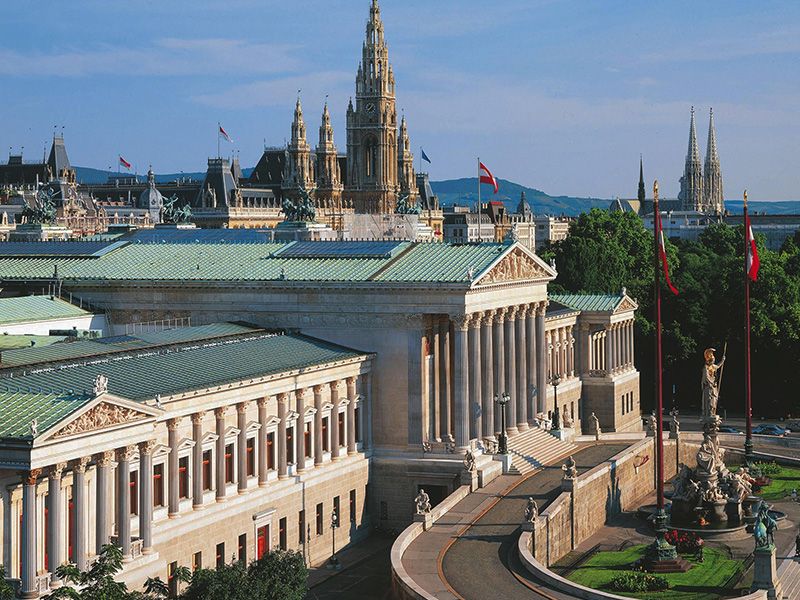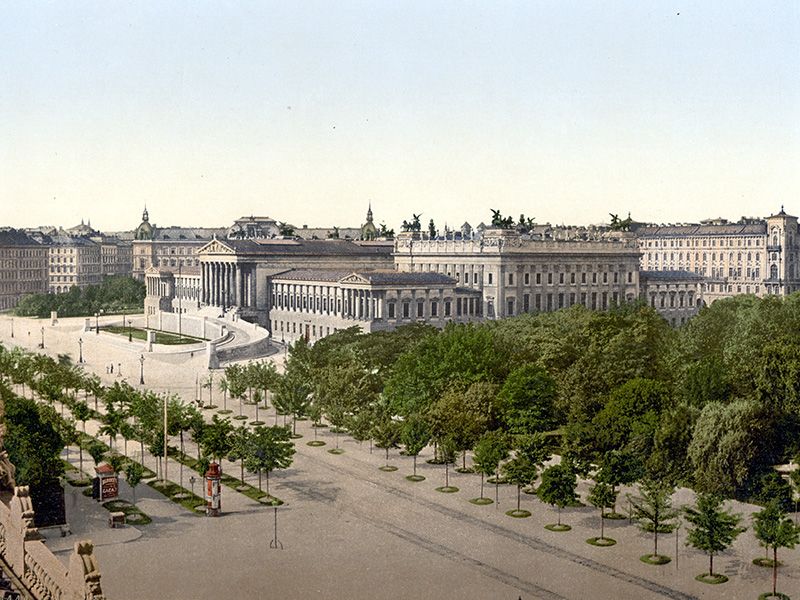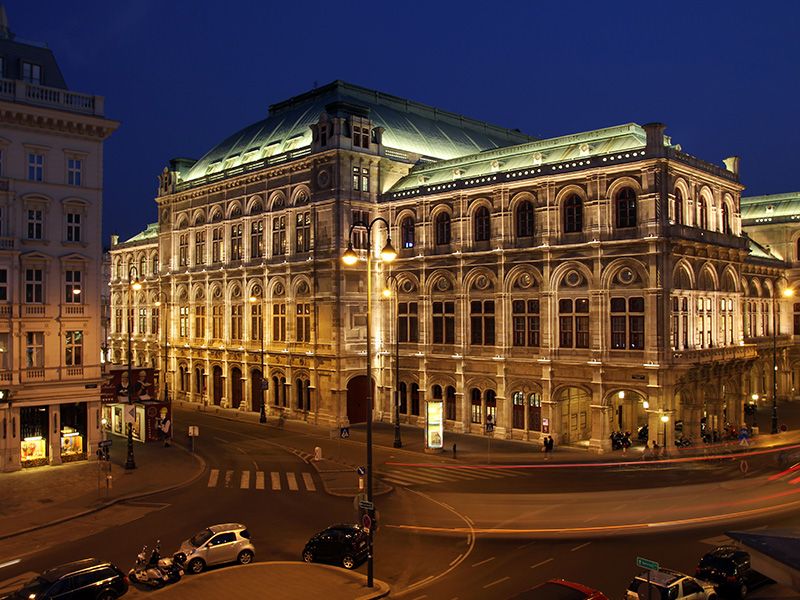Vienna’s iconic Ringstrasse boulevard stands as a testament to the city’s architectural transformation in the 19th century. This 3-hour walking tour led by a historian offers visitors a captivating exploration of the grand buildings lining the Ringstrasse, from the neo-Renaissance Opera House to the neo-Gothic City Hall. Through this immersive experience, you will uncover the dramatic history and the architects’ vision that shaped this architectural masterpiece, revealing how the Ringstrasse redefined Vienna’s urban landscape and solidified its status as a center of wealth, power, and cosmopolitanism. Delve deeper into this fascinating chapter of Viennese history and discover the secrets that lie within the Ringstrasse’s grand facades.
Key Points

- The Ringstrasse boulevard is a 5-mile ring-shaped avenue showcasing Vienna’s wealth, power, and architectural diversity through grand buildings in various styles.
- A 3-hour walking tour led by a historian explores the Ringstrasse’s iconic buildings, including the City Hall, Votive Church, and Burgtheater, while uncovering the dramatic history behind its construction.
- The demolition of outdated medieval city walls in 1857 was a pivotal moment in Vienna’s urban transformation, clearing the land for the grand Ringstrasse project.
- Renowned architects like Ferstel and Hansen left their mark on the Ringstrasse, designing buildings that embody the elegance and sophistication that define this iconic avenue.
- The tour includes a visit to Café Schwarzenberg, a Viennese institution since 1861, offering a glimpse into the city’s renowned café culture and its relaxed, leisurely atmosphere.
Vienna’s Dramatic Architectural Transformation

Vienna’s once-sleepy medieval cityscape underwent a dramatic architectural transformation with the construction of the grand Ringstrasse in the 19th century.
The emperor’s order to demolish the outdated city walls paved the way for this bold new boulevard, designed to showcase Vienna’s wealth, power, and readiness for modernity.
The Ringstrasse became home to an array of striking buildings in diverse architectural styles, from the neo-Renaissance Vienna City Hall to the neo-Gothic Votivkirche.
Renowned architects like Heinrich von Ferstel and Theophil Hansen left their mark on the Ringstrasse, creating a harmonious yet visually captivating ensemble that redefined Vienna’s urban landscape and solidified its status as a cosmopolitan European capital.
If you're enjoying exploring Vienna on foot, you'll love these other walking tours we recommend
Exploring the Iconic Ringstrasse Boulevard
Stretching for nearly 5 miles, the Ringstrasse is Vienna’s iconic ring-shaped boulevard that enchants visitors with its diverse architectural wonders.
Guided by a knowledgeable historian, this 3-hour walking tour explores the Ringstrasse’s magnificent buildings, each reflecting a different architectural style. From the neo-Renaissance Vienna City Hall to the neo-Gothic Votive Church, the tour uncovers how this grand boulevard became the hub of Viennese high society.
Along the way, guests discover the dramatic history behind the Ringstrasse’s construction, as the Austrian emperor ordered the demolition of the city’s outdated medieval walls to make way for this modern symbol of Vienna’s wealth and power.
Showcasing Vienna’s Wealth and Power

The Ringstrasse’s construction was a bold statement, showcasing Vienna’s wealth, power, and readiness for modernity. Through its grand architecture and opulent design, this iconic boulevard demonstrated the city’s ambition to establish itself as a leading European capital.
The wide, ring-shaped street was built upon the site of the city’s outdated medieval walls, which the Austrian emperor had ordered demolished in 1857. Lined with lavish palaces, museums, and government buildings, the Ringstrasse became a symbol of Vienna’s transition into a cosmopolitan, forward-thinking metropolis.
Its dramatic showcase of power and prestige reflected the Habsburg monarchy’s desire to project an image of strength and sophistication to the world.
Demolition of the Medieval City Walls
In 1857, the Austrian emperor’s order to demolish Vienna’s outdated medieval city walls paved the way for the construction of the renowned Ringstrasse.
This dramatic decision was a pivotal moment in Vienna’s urban transformation. The old fortifications had become obsolete, constraining the city’s growth and development.
By clearing the land, the emperor opened up space for a grand, ring-shaped boulevard that would showcase Vienna’s emerging cosmopolitanism and modernity.
The Ringstrasse project was an ambitious undertaking, requiring significant planning and investment. But it ultimately succeeded in redefining the city’s visual identity, replacing the medieval walls with a series of impressive architectural landmarks that have since become iconic symbols of Vienna.
More Great Thing To Do NearbyRingstrasse: Vienna’s Modern Masterpiece
Constructed in the 19th century, Vienna’s Ringstrasse Boulevard is a majestic, ring-shaped avenue that encircles the city’s historic center, showcasing its wealth, power, and readiness for modernity.
Designed to replace the outdated medieval city walls, the Ringstrasse is lined with impressive buildings in a variety of architectural styles, from neo-Renaissance to neo-Gothic.
As the hub of Viennese society, the boulevard is home to grand palaces, prestigious universities, and iconic cafes like Cafe Schwarzenberg, which opened in 1861.
Today, the Ringstrasse remains a testament to Vienna’s cosmopolitanism and serves as a popular destination for visitors to explore the city’s rich history and architectural heritage.
Here are more great tours and experiences we've reviewed in Vienna
Architects Behind the Ringstrasse Buildings
Along the Ringstrasse, visitors can admire the work of some of Vienna’s most renowned architects, who left their mark on the boulevard’s iconic buildings.
The neo-Renaissance Opera House was designed by Eduard van der Nüll and August Sicard von Sicardsburg, while the Parliament Building showcases the neo-Greek style of Theophil Hansen.
Nearby, the Rathaus or City Hall was crafted in the neo-Gothic idiom by Friedrich von Schmidt.
Further down the ring, the Burgtheater, one of Europe’s most renowned opera houses, is a product of Karl Freiherr von Hasenauer’s artistic vision.
From the grandiose to the ornate, these architectural masterpieces embody the elegance and sophistication that define the Ringstrasse.
Experiencing Viennese Café Culture
One of the highlights of the Ringstrasse walking tour is a visit to Café Schwarzenberg, a Viennese institution opened in 1861 that offers visitors a glimpse into the city’s renowned café culture.
As the guide leads the group inside, they’ll discover the ornate, historic interiors that evoke a bygone era of elegance and refinement.
The extensive menu of traditional Viennese pastries, coffee specialties, and light meals is also a highlight.
Visitors will experience the relaxed, leisurely atmosphere where locals and visitors alike linger over their drinks and nibbles.
Through this immersive experience, participants gain a deeper appreciation for the enduring importance of café culture in shaping the character of Vienna.
Cancellation Policy and Tour Details
Travelers can easily cancel their Ringstrasse walking tour up to 24 hours in advance for a full refund.
The tours are available in both private and small group formats, with English-language guides leading the 3-hour experience.
This provides flexibility for visitors to plan their schedules accordingly.
The walking tour explores Vienna’s famous ring-shaped boulevard, showcasing the dramatic architectural styles of the buildings lining the Ringstrasse.
Guests will discover how this grand boulevard became the hub of Viennese society, learning about the history and significance of this iconic landmark from knowledgeable guides.
Whether visiting solo or with a small group, the Ringstrasse tour offers an engaging and informative way to experience Vienna’s rich cultural heritage.
Frequently Asked Questions
What Is the Typical Group Size for the Tour?
The tour offers both private and small group options. Small group tours typically accommodate up to 10 participants, providing an intimate and interactive experience with the historian guide.
Do the Tours Operate Year-Round?
The Ringstrasse walking tours operate year-round, allowing visitors to explore Vienna’s iconic boulevard regardless of season. The tours run regularly, providing a comprehensive look at the boulevard’s architectural highlights and historical significance.
Are There Any Discounts Available for Students or Seniors?
The tour company offers discounted rates for students and seniors. Participants can save a certain percentage off the regular price by providing valid student or senior identification upon booking or check-in.
Can the Tour Be Customized to Focus on Specific Interests?
Yes, the tour can be customized to focus on specific interests. The private or small group tours allow for flexibility to tailor the experience to the group’s preferences, such as architectural highlights, cultural insights, or historical themes.
How Accessible Is the Walking Tour for Individuals With Mobility Challenges?
The walking tour is generally accessible for individuals with mobility challenges. Private tours can accommodate varying mobility levels, with options like taxi transfers or a shortened route. The tour provider offers assistance to ensure an enjoyable experience for all participants.
Recap
The Ringstrasse walking tour provides visitors with a captivating exploration of Vienna’s architectural transformation and its quest for modernity.
Participants enjoy the grand buildings that line this iconic boulevard, uncovering the dramatic history and architects’ vision that shaped this architectural masterpiece.
The tour offers a comprehensive understanding of how the Ringstrasse redefined Vienna’s urban landscape and solidified its status as a center of wealth, power, and cosmopolitanism.
You can check if your dates are available here:More 3-Hour Experiences in Vienna
- Private 3-Hour Walking Tour of Vienna
- Private Transfer From Vienna to Salzburg With 3h Sightseeing Stop in Hallstatt
- Vienna: 3-Hour Private Walking Tour
- 3-Hour Private Hiking Tour to Historic Places Around Spitz in Wachau Valley
- 3 Hour Private Tour in Vienna With Private Car
- 3 Hour Private Tour in Vienna by Private Car
More Walking Tours in Vienna
- World War II History Vienna Old Town Private Walking Tour
- Vienna Full Day Private Shore Excursion, Van&Walk
- Walking Christmas Tour Filled With Magic in Shkodra
- Vienna River Cruise, Walking Tour With St. Stephan Cathedral
- Take Stunning Photos of Yourself While Walking Vienna
- Incredible Vienna – Walking Tour for Couples
More Tour Reviews in Vienna
Not for you? Here's more things to do in Vienna we have recnetly reviewed
- 3 Best Craft Beer Tours And Tastings In Vienna
- 18 Best Christmas Experiences In Vienna
- 25 Best Cruises And Boat Tours In Vienna
- 22 Best Food Tours In Vienna
- 9 Best Full-Day Tours In Vienna
- 5 Best Coffee Tours And Tastings In Vienna
- 12 Best Lunch Experiences In Vienna
- 13 Best Photography Experiences In Vienna
- 21 Best Dining Experiences In Vienna
- 20 Best Dinner Tours In Vienna
- Vienna as Never Seen Before: Hidden Courtyards, Legends and Symbols
- Private Day Trip to Bratislava From Vienna
